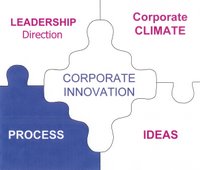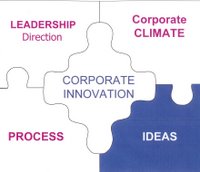
THE INNOVATION RADAR
One of the important things we drive in the Market Driven Growth process is that a great product or service in itself does not mean success. A company has to build an entire Business System around its offering to make it work. We use the methodology developed by Sawhney and Wolcott to "force" businesses to think through all the major issuse using the Innovation Radar ("....business innovation is far broader in scope than product or technological innovation. In fact, a company can innovate along any of 12 different dimensions with respect to its (1) offerings, (2) platform, (3) solutions, (4) customers, (5) customer experience, (6) value capture, (7) processes, (8) organization, (9) supply chain, (10) presence, (11) networking, and (12) brand" http://sloanreview.mit.edu/smr/issue/2006/spring/14/).
Microsoft's challenge in combating Apple's iPod touches on issues in all the axes. This example talks about four of them.
This first artcile presented below appeared in July of this year prior to the formal Zune announcement. The second article was published yesterday summarizing the initial reaction of the market to Zune.
CHALLENGES FACING A NEWCOMER -- THE ZUNE CHALLENGE EMERGIC.org - July 24, 2006 Microsoft's Zune News.com writes about the new device and service which will rival iPod and iTunes: Michael Gartenberg
........The initial Zune device will have Wi-Fi and use a hard drive to store music, Microsoft said. Stephenson's statement also lent some credence to speculation that the company's player will use wireless connectivity to share music with other Zune devices.
So what's the challenge? Essentially there are three things.
Creating a technically competent challenger (Offering) - Arguably this is the easiest thing for them to do. Apple's shown the way on what features the market wants. Less obvious are how Microsoft will differentiate with features like WiFi, that few mainstream consumers want and serve as a something that not only boosts for the bill of materials but also kills important features like battery life. Good news is the focus is on music and video.
Creating a lifestyle device (Brand and Customer Experience) - Microsoft is clearly going to face a battle here. It's good that they're building a unique brand and following the Xbox tradition, distancing themselves somewhat from Microsoft identity but that's not enough. Zune isn't a bad name. It's going to be hard for them to create the same level of cachet that Apple has with the iPod.
Creating a platform(Platform)- iPod is more than a single device. It's a platform in and of itself with a whole eco system of cases, car kits, speakers and docks. No doubt that MSFT will work hard to make sure that they fill some of the gap directly with first party stuff, but this is one area where consumer choice goes a long way in making the platform a success.
Here is what was in yesterday's WSJ..... Microsoft's ZuneFalls Off Sales PaceFor Media Players By CARMEN FLEETWOODNovember 28, 2006; WST, Page B2
Top 10 selling list for electronics yesterday, seven of the 10 products were digital media players. Nowhere did the Microsoft Corp. or Zune names appear. "That's a pretty good indicator of consumer interest," Michael Gartenberg of industry group Jupiter Research said yesterday, one of the busiest days of the year with online shoppers.
The 30-gigabyte Zune player from Microsoft, which retails for $249, was on the Top 10 list of Amazon, the largest Internet retailer, for several days after its release on Nov. 14 before dropping off. But yesterday, the most popular model of the Zune, the black version, was at No. 76. The Top 10 digital media players included six iPods from top-seller Apple Computer Inc. and one MP3 player from SanDisk Corp. The 30-gigabyte iPod has a $249 list price and ranked No. 2 at one point yesterday. "The product [Zune] wasn't particularly attractive. At the end of the day, you put it on a shelf and it just didn't compare," said Rob Enderle of research firm Enderle Group.
Microsoft has noted the Herculean effort it would take to overcome the lead Apple has built up in the digital media market in five years since the introduction of the iPod. Microsoft is trying to build up a total ecosystem with the product and the Zune Marketplace music Web site in order to compete with Apple and its iTunes store. Sales of Zune in the first week after the Nov. 14 launch were "exactly within our expectations," a Microsoft spokeswoman said. She added that she is still awaiting information for holiday weekend sales.
Analysts say the Zune is more likely to snag market share from other digital media players instead of Apple this holiday season. ........... Zune received accolades for its built-in wireless capability and ability to share music with other Zune users for three plays, something not available in the iPod . A larger screen than available on the iPod and a built-in FM radio were noted as positives for the Zune, which is also available in white and brown (Some Offering features seem sound). Critics found the Zune Marketplace, where Zune owners must buy their music, confusing. Also, the Zune is incompatible with Apple's iTunes store (Customer experince is critical). The Zune doesn't support podcast audio programs nor can it transfer television and video programs from Microsoft's Media Center. Others have faulted the lack of videos available on the Zune Marketplace site, and the device's heavier weight and shorter battery life to an equivalent iPod were negatives to consumers seeking to purchase an MP3 player.(These are some real negatives. What good is a larger screen if you do not have videos).
The importance of looking at the whole system is critical!!!!


